Hernstein
U. S. A. Hosp. Dept. Field Surgery Set
Used by Documented
Gettysburg Surgeon Frank Ridgway
73 rd & 74th Regt's
N.Y.V.
Hermann Hernstein surgical instruments (major supplier of
instruments to the U.S.A. Hosp. Dept.)
1851-52: 68 Duane
1853-54: 81 Duane
1855-57: 81 Duane
and 393 Broadway
1858: 81 Duane, 131
Mercer, and 393 Broadway
1859-61: 131 Mercer and 393 Broadway (pre-War)
Hermann Hernstein & Son
(Hermann and Albert L. Hernstein)
1862-65: 131 Mercer and 393 Broadway
(Mid-War)
Hermann Hernstein & Son
& Co.
1865: 2 Liberty and
393 Broadway (Post War)
Above reference:
Edmonson
This early Civil War period set
is three layer (16 x 6 1/4 x 3 3/4
in.) mahogany, purple velvet lined case and is
typical early Hernstein military issue with sliding latches and no key lock. There are no brass
screws as are seen on later military sets, but the exterior corner-pieces are there for re-enforcement as is normal for
military issue. Instruments are marked for the
U. S. Army Hospital
Department, with both Hernstein and Hernstein & Son to key on for the date and source.
There are three levels of
the case: lid with removable partition, removable tray, and the lower
section for a set of gullet forceps, urinary sounds and
catheters. This type of set would have seen service in the
field rather than in a rear area hospital.
Frank Ridgway,
M.D. Graduate of New York University, Medical College, 1860 - 1861
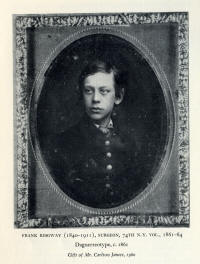 According to the Roster of Regimental
Surgeons and Assistant Surgeons, Frank Ridgway, M.D. transferred to the 74th
infantry from the 73rd infantry in July 1863, and mustered out of the
74th on July 26, 1864. According to the Roster of Regimental
Surgeons and Assistant Surgeons, Frank Ridgway, M.D. transferred to the 74th
infantry from the 73rd infantry in July 1863, and mustered out of the
74th on July 26, 1864.
Frank Ridgway, (born 1840) was as an
assistant surgeon in the Second Fire Zouaves, which was commissioned on
Nov 27, 1861, after which they were known as the 73rd New York
Volunteers. They consisted mainly of fireman and runners from New York.
They were originally camped near Washington, D.C., then were in the
battle of Yorktown, Fredericksburg, as well as Gettysburg.
Frank Ridgway, age 22 years;
enrolled July 17, 1861, at Camp Decker to serve three years ; mustered
in as Assistant Surgeon, September 5, 1861 ; discharged, June 30, 1863,
for promotion to Surgeon, 74th Infantry ; commissioned Assistant
Surgeon, November 27, 1861, with rank from September 5, 1861.
Assistant Surgeon Ridgway was in the
73rd NY, Excelsior Brigade with Gen. Sickles. He saw action thru
Chancellorsville. Then, just before Gettysburg, he was
promoted/commissioned as a Surgeon in the 74th NY, also he was with the
Excelsior Brigade and Gen. Sickles, which saw heavy action at
Gettysburg. Ridgeway was with the 74
and 73 rd NY (Excelsior Brigade) for the duration of the war. He was
promoted Surgeon 6/30/63 just prior to Gettysburg. The engraved cartouche on the lid of the case
indicates Ridgway was involved in twenty eight battles. Truly a
lucky man to have survived the War and it may have influenced the
professional decisions he made after the War.
Read the
full article published in the 1961 New-York
Historical Society Quarterly about Frank Ridgway and his
exploits during the Civil War 1861 to 1864, based on
Ridgway's personal diary. Also shown are citings
or operations performed by Ridgway from the Medical and
Surgical History database.
Following his discharge, he did not
follow a medical career, instead he entered the construction field. He
is listed in the 1880 census, living in Richmond, Staten Island. He
did have 2 daughters, Clara and Mary who donated his papers and
this surgery set to the New York University in 1924 (see note attached to
the surgery set) according to "Report of the President, by New York
University, Published by the University, 1956, item notes: 1924 - 1925.
The set was then given to a New York doctor, who later gave it to a
surgeon friend from whom I procured the set.
From Frank Ridgway's Diary :
"From the Wilderness to Petersburg: The Diary of
Surgeon Frank Ridgway." Edited by James J. Heslin.
New-York Historical Society Quarterly,
45 (April 1961), pp. 113-140. [73d New York
Volunteer Infantry 4th Excelsior Regiment)]
Additional information on the
73rd Infantry N.Y.
Volunteers
Click on any image to enlarge

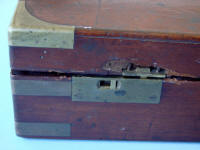

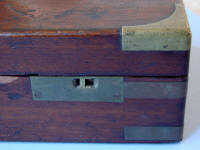
Damage to the case by someone who
couldn't figure out how the 'sliding latch ' unlocks!
Exterior of the Hernstein set,
showing the cartouche (brass name plate) in the center of the case
|
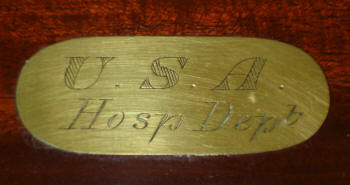 |
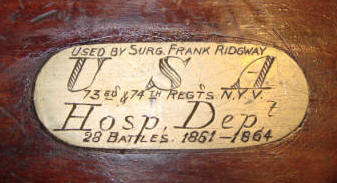 |
| Above:
An example of the 'Primary' factory engraving of the
cartouche (brass name plate) from a mint
1865 Hernstein set in this collection, showing just the
engraving for:
U.S.A. / Hosp. Dept.
|
Above:
The cartouche of this Hernstein set used by Frank Ridgway.
There is a 'Primary' factory engraving of
U.S.A. /
Hosp. Dept.
(similar to the one to the left from a later Hernstein set),
and a later 'Secondary' post-Civil War engraving of the
cartouche:
"Used by Surg. Frank Ridgway / 73rd & 74th Regts N.Y.V
/ 28 Battles, 1861 - 1864"
|
|
Obviously the 'Secondary ' engraving
is not factory original and was added after the War as is typical for
presentation sets. These sets were owned by the Federal
Government, not an individual, and if engraved after the War as a
'presentation' then the engraving is secondary to the original ownership
by the government. There is also a four year time frame difference
and obviously there was another
engraver involved between the original factory example on the left and
the 'Primary' factory example on the right.
The engraving which was added to the
original 'Primary' engraving is obviously not intended to 'fool' anyone,
but rather is an effort to document Ridgway's exploits during the War by
whomever 'presented' this set to him as a gift.
|
|
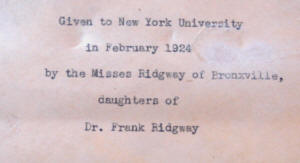 |
 |
|
An old hand-typed note is glued over
the embossed Hernstein Eagle on the partition, detailing the set as:
"Gift to
the New York University in February 1924 / by the Misses
Ridgway, of Bronxville, N.Y. / daughters of /
Dr. Frank Ridgway"
This information is
documented (Google Books) in a publication of the New York University
President's Report, describing
the donation of Frank Ridgway's papers and surgical set in 1924 to the
New York University by his daughters after his death in honor of
his having graduated from the New York University medical school.
|
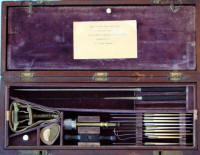
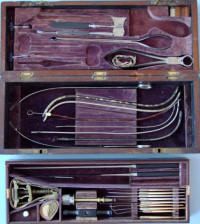
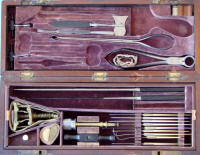
Obviously there are a number of
instruments missing including the capital saw, but what is there is rare and
telling



|
A similar Hernstein
set with some of the missing instruments from the Ridgway set |
|
 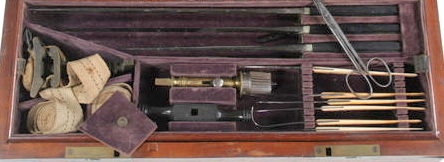 |
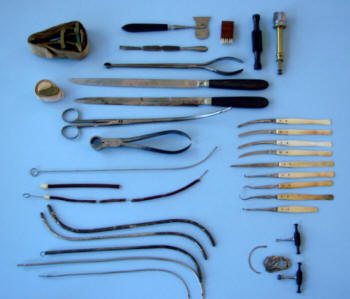
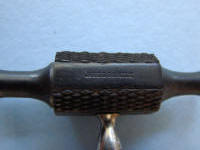
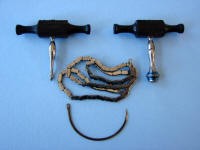

This chain saw has the 'Hernstein' name
impressed on both handles
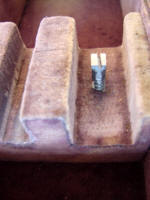
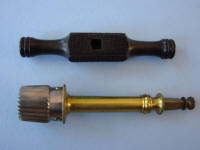

Interesting use of a cut-head screw to
hold the handle in place


Gullet forceps from the bottom of the
case, marked: 'Hernstein' on one side and 'USA
Hosp. Dept.' on the other
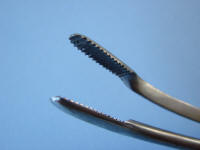

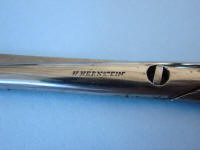
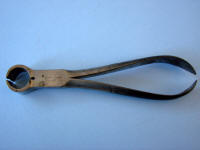
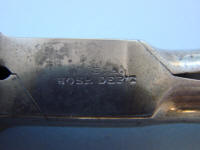
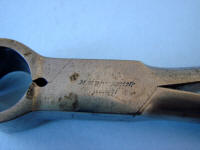
Bone forceps marked: 'Hernstein' on
one side and 'USA Hosp. Dept.'
on the other
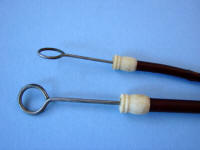

These two original-to-the-set broken
catheters document an important fact: they were using 'French' leather
catheters with ivory collars during the War. For more information
on this issue, see: Sounds and Catheters on
this site

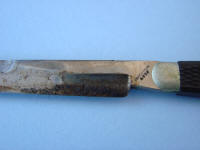
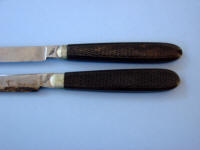
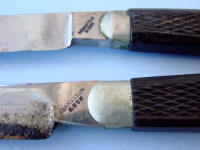
Note the lower catlin amputation
knife is coated with crusted blood, both knives are marked: 'Hernstein &
Son'

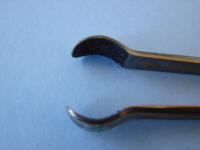
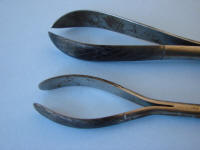
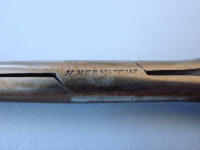
Bullet forceps with 'Hernstein' mark,
the handles on both bullet and bone forceps are cross-hatched
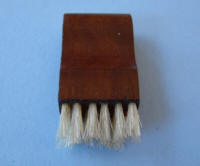
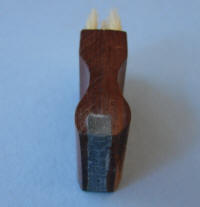
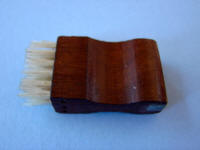
The bone brush is unique in that
it appears to have a sharpening stone (?) embedded in the back
end and is unlike any other this collector has seen in a Hernstein
set
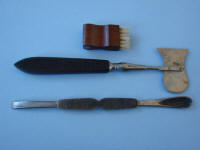
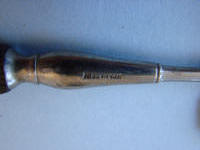
The Hey saw is marked: 'Hernstein'
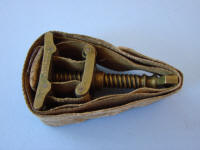
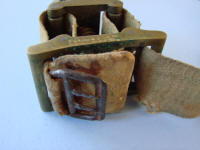
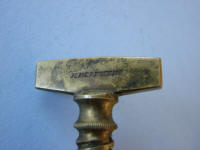

Above is a typical, but
very large screw-type tourniquet with the brass 'T'
marked 'Hernstein', plain cloth strap, forged iron
buckle clamp
Below is a 'field' tourniquet and marked:
'Hernstein' /
U.S.A. Hosp. Dept'
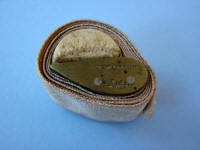
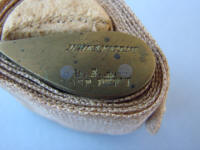

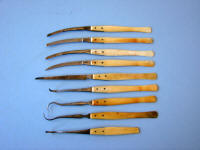
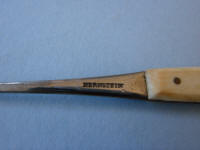
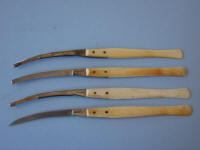

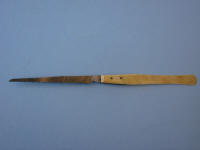
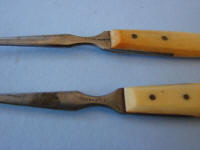
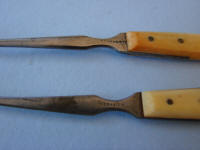
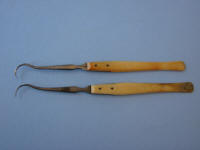
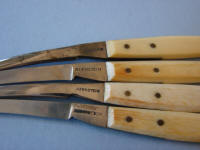
Set of ivory handled bistories, tenaculae, artery
needles, finger saw, but curiously no standard scalpels
|






